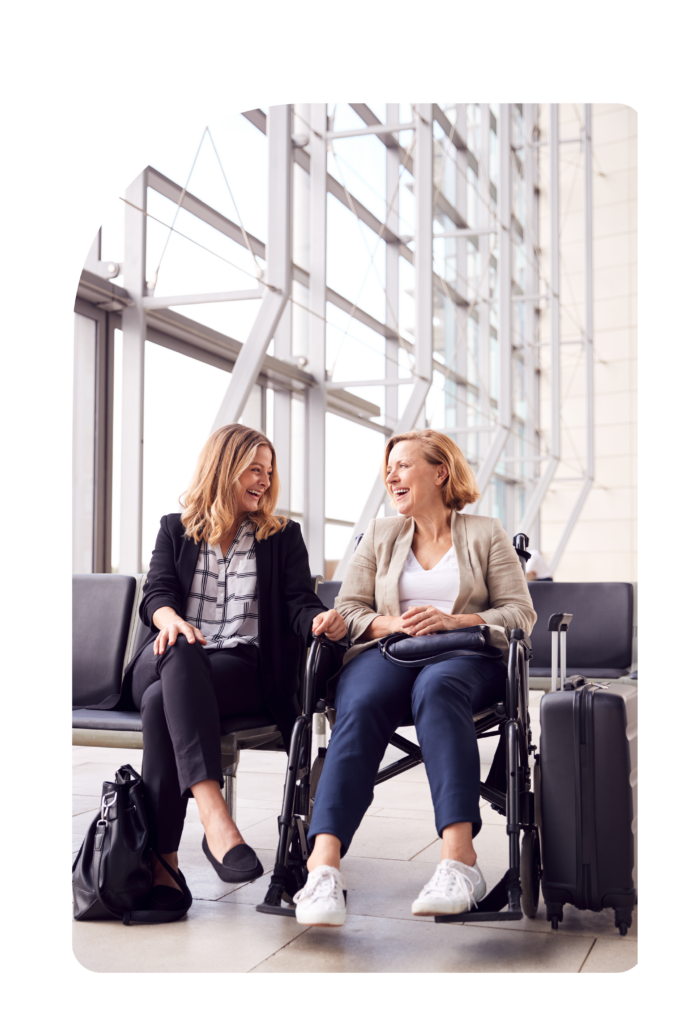March 8, 2023
In part one of this blog post series, we helped you prepare for a flight. There’s a lot to do before you get to the airport! If you missed it, check out that blog post by clicking the button below.
Getting Through Security and the Airport Terminals
Checking In
If you made prior arrangements for assistance, many airlines will have someone to meet when you arrive at check-in. They will provide you with a wheelchair, if you need one, and help guide you through security. You should also verify any other accommodation requests with the person at the check-in counter.

Security Checkpoint
Your experience with getting through security can vary depending on disability, TSA staff training, and even the airports themselves. However, most common procedures to know are:
- Persons with disabilities are not expected to remove their shoes for a screening
- You may opt for a pat-down or private screening in lieu of body scanners
- Medically-necessary liquids are exempt from the 3-1-1 rule, but must be inspected
The TSA has a helpful list of disability-related situations on their website. With this list, you can have a better understanding of what to expect. There may be specific instructions based on your needs. For other questions, contact TSA Cares prior to flying.
Time to Hit the Skies
Be sure you check in with your gate agent prior to your flight. Pre-boarding and other boarding accommodations can be arranged or confirmed at this point. This includes aisle chairs for wheelchair users, plug-ins for portable oxygen containers, and more.
Pre-boarding allows you more time to get settled on board the plane. For airlines without assigned seats, you will also get to choose any seat.
Assistance While in the Air
You may need assistance during the flight. For example, flight attendants can help open food packages, but cannot feed passengers. They can also assist with getting a person to the bathroom, but not with using it.
If you need more help than what flight attendants can provide, you may want to travel with someone who can help.

Medications, De-Stressors, and More
Here are a few general tips to make flying a bit easier:
- If you take medication at a certain time, wear a watch that stays on your home time zone. This can help you stay on routine with time-sensitive medicines.
- Pack comfort items, such as a small blanket or your favorite cozy sweatshirt, in your carry-on bag for easy access mid-flight.
- Bring noise-canceling headphones to help block out engine and passenger sounds. But, make sure to download your favorite playlist to your device before takeoff. Many airports have free Wi-Fi you can use to do this while you wait to board the plane.
If You Have a Problem…
…don’t wait until your trip is over to speak up. You can request to speak with the airline’s Complaint Resolution Official (CRO) or a supervisor. A CRO is the airline’s expert on disability-related issues in air travel. They can resolve complaints on behalf of the airline. According to the Department of Transportation, every airline must have a CRO available during operating hours.
You can also call the DOT Aviation Consumer Protection Division’s Disability Hotline at 800-778-4838. For a full list of recommendations, please see the DOT’s website.
You Have a Right to Travel by Airplane
We recommend talking to others with similar needs to your own about their travel experiences. Or, search for blog posts from others with the same disability as you. They may have tips or tricks that we didn’t mention here.
Flying can be stressful for anyone; there are a lot of things to remember and a lot of things that could potentially go wrong. But if you’re confident and well-prepared, it can be manageable — and even enjoyable. Plan ahead, communicate your needs clearly and often, and have fun!
Read More on the Department of Transportation’s Website
Review training videos provided to airline employees and see informational brochures here. Also, you can read the Airline Passengers with Disabilities Bill of Rights.
